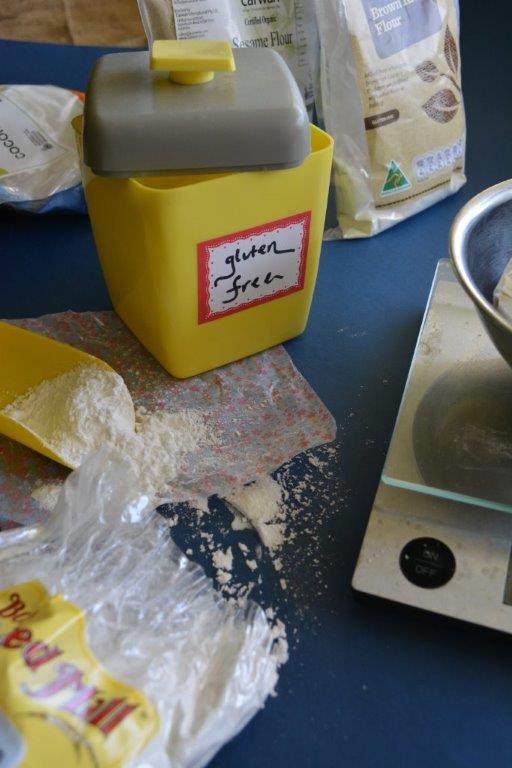Developments in gluten-free food means that there are now plenty of gluten-free flour options. But how do you decide what will work best?

Have you ever noticed all the gluten-free flours that are out there? There are just so many of them, it’s hard to know where to start.
I wrote about gluten-free flours in the introductory pages of my eCookbook and I’ve reproduced an amended version below. I hope it’s of some use to you, and more importantly, I hope it saves you the cost and inconvenience of buying a heap of flours that you’ll hardly ever use.
*********************************************************************************************************
If you’ve been dabbling in gluten-free baking for any amount of time, you will have come across a vast range of gluten-free flours. There seem to be more on the market each week. In addition to the plain (all-purpose) and self-raising flour mixes that are now sold by most supermarkets, you can find other “whole” flours including:
- Coconut flour
- Tapioca flour (or starch)
- Potato flour
- Banana flour
- Teff flour
- Rice flour
- Quinoa flour
- Amaranth flour
- Sorghum flour
- Besan (chickpea) flour
- Sesame flour
- Buckwheat flour
- Almond flour (or meal)
- Lentil flour
- Green banana flour
- Tigernut flour
The list goes on.
You could stock your pantry with all of these flours but the truth is that you’ll never use most of them and others you’ll use only once or twice. That’s an expensive way to explore your gluten-free world.
When it comes to gluten-free flours, there are a few fundamentals to keep in mind:
- A mixture of flours works so much better than using just one flour
- A starchy flour should be included in a gluten-free flour mix
- The higher the protein content, the better
- It’s best to weigh your flours rather than use cup measurements, as the varying fineness of their texture means that, for example, a single cup of one flour will differ in weight from another flour
My favourite gluten-free flours
Through much trial and error, I have come up with my own flour combination that uses tapioca flour (or tapioca starch) and high protein flours: sorghum flour and brown rice flour. You will find this trio of flours in most of my cake and muffin recipes.
Occasionally, I use sesame flour or coconut flour, as they have distinctive tastes. Sesame flour also has an oily texture, similar to almond flour and other nut flours, so it’s a great option to use in their place, for example in my recipe for Apple and Maple Scones.
If you’ve ever cooked with any of the nut flours, you’ll know that they work wonders in gluten-free baked goods. They lock in the moisture and ensure a dense texture that prevents your cakes from crumbling before your eyes. But if you have a pre-school or school-aged child, you will also know the dangers of packing nut products in your child’s lunchbox. No one wants to be responsible for causing an anaphylactic reaction in any child. That is an added challenge for the gluten-free lunchbox and for that reason, all of my recipes are nut-free.
For other recipes, such as biscuit, cookie and pikelet recipes where it’s not so important to achieve a lovely airy texture, I have used plain or self-raising flour mixes from the supermarket. They work just fine for those recipes and it’s great to have the option of occasionally using something that’s been pre-mixed. But you should bear in mind that different brands of gluten-free flour mixes can vary in absorbency. You need to be aware of the consistency of whatever you are baking and add more flour or more liquid depending on the brand you are using. I tend to favour the Orgran brand of flour mixes.
BUY NOWReferences
Food 52: Why you should always measure non-wheat flours by weight
Gluten-free Baking for Dummies
What’s your favourite gluten-free flour combination? Leave a comment below.

Leave a Reply